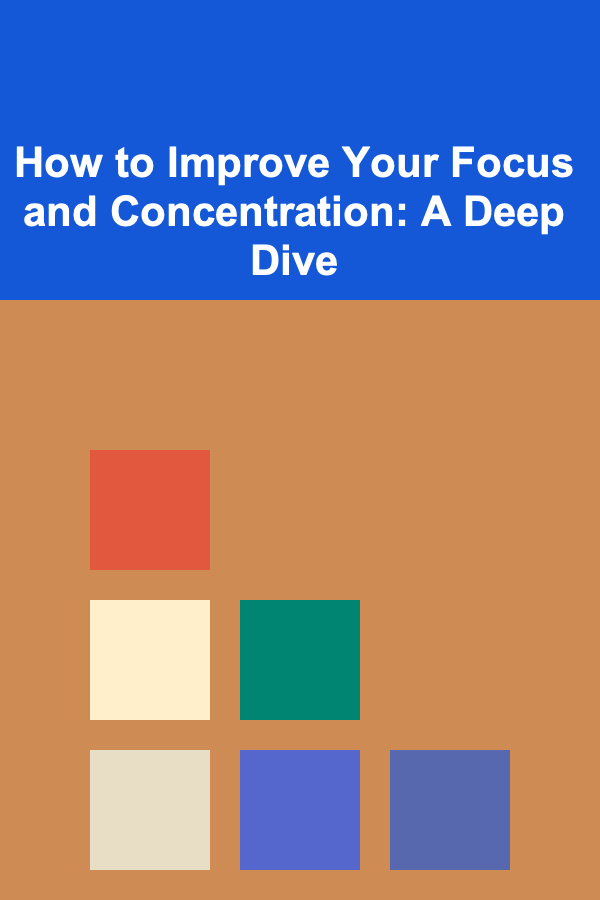
How to Improve Your Focus and Concentration: A Deep Dive
ebook include PDF & Audio bundle (Micro Guide)
$12.99$8.99
Limited Time Offer! Order within the next:

In today's hyper-connected world, focus and concentration are increasingly valuable, yet increasingly elusive. We are bombarded with information, notifications, and distractions that constantly pull us away from the task at hand. The ability to concentrate deeply and maintain focus is not just a skill for academic success or professional advancement; it's a fundamental component of a fulfilling and productive life. This article delves into the science behind focus and concentration, explores the common challenges we face, and provides practical, actionable strategies to enhance your ability to stay present and engaged.
Understanding the Science of Focus
To effectively improve focus, it's crucial to understand the underlying neurological processes. Focus is not a monolithic entity but rather a complex interaction of various brain functions. Here are key aspects to consider:
The Attentional Control Networks
Our brains have intricate networks responsible for attentional control. Two of the most prominent are the dorsal attention network (DAN) and the ventral attention network (VAN).
- Dorsal Attention Network (DAN): This network is responsible for top-down, goal-directed attention. It's activated when we intentionally focus on something, such as reading a book or solving a problem. The DAN involves brain regions like the frontal eye fields (FEF) and the intraparietal sulcus (IPS).
- Ventral Attention Network (VAN): This network is responsible for bottom-up, stimulus-driven attention. It's activated when something unexpected or salient captures our attention, such as a sudden noise or a flashing light. The VAN involves regions like the temporoparietal junction (TPJ) and the ventral frontal cortex (VFC).
A healthy balance between these networks is essential. We need the DAN to maintain focus on our goals, but we also need the VAN to be aware of important changes in our environment. However, in our modern environment, the VAN is often overstimulated by constant notifications and distractions, disrupting the DAN's ability to maintain focus.
The Role of Dopamine
Dopamine, a neurotransmitter associated with reward and motivation, plays a critical role in focus and concentration. When we anticipate a reward or achieve a goal, dopamine is released, which reinforces the behaviors that led to that outcome. This helps us stay motivated and engaged in tasks.
However, the dopamine system can be hijacked by short-term rewards, such as social media notifications or sugary snacks. These provide a quick dopamine hit but don't contribute to long-term goals. This can lead to a cycle of seeking instant gratification and difficulty focusing on more challenging or less immediately rewarding tasks.
The Prefrontal Cortex and Executive Functions
The prefrontal cortex (PFC) is the brain's "executive control center." It's responsible for higher-level cognitive functions, including:
- Working Memory: Holding information in mind and manipulating it.
- Cognitive Flexibility: Shifting between different tasks or perspectives.
- Inhibitory Control: Suppressing distractions and impulses.
All of these functions are crucial for focus and concentration. When the PFC is impaired, due to stress, lack of sleep, or other factors, our ability to focus suffers. Strengthening the PFC through targeted exercises and lifestyle changes is a key strategy for improving focus.
The Default Mode Network (DMN)
The default mode network (DMN) is active when we're not focused on a specific task and our minds are wandering. It's associated with self-referential thought, daydreaming, and mind-wandering. While the DMN is important for creativity and self-reflection, it can also be a major source of distraction when we're trying to focus.
Learning to regulate the activity of the DMN is crucial for improving focus. Mindfulness meditation and other practices can help us become more aware of our thoughts and feelings and redirect our attention when our minds wander.
Common Challenges to Focus and Concentration
Understanding the biological basis of focus helps us identify the common challenges we face in maintaining it. Here are some of the most prevalent obstacles:
Environmental Distractions
Our environment is often filled with distractions that constantly pull our attention away from the task at hand. These can include:
- Noise: Loud noises, conversations, and music.
- Visual Distractions: Clutter, movement, and bright lights.
- Technology: Notifications, emails, and social media.
Internal Distractions
Internal distractions are thoughts, feelings, and sensations that compete for our attention. These can include:
- Mind-Wandering: Our thoughts drifting to other topics.
- Worries and Anxieties: Concerns about the future or regrets about the past.
- Physical Sensations: Hunger, fatigue, and discomfort.
Lack of Sleep
Sleep deprivation has a profound impact on cognitive function, including focus and concentration. When we're sleep-deprived, our PFC is impaired, making it difficult to control our attention and suppress distractions.
Stress and Anxiety
Chronic stress and anxiety can also impair focus. When we're stressed, our bodies release cortisol, a stress hormone that can interfere with cognitive function. Anxiety can also lead to racing thoughts and difficulty concentrating.
Multitasking
Despite the common belief that multitasking is an efficient way to get things done, research has shown that it actually reduces productivity and impairs focus. When we try to do multiple things at once, our brains have to constantly switch between tasks, which is mentally exhausting and leads to errors.
Poor Diet and Hydration
Our diet and hydration levels can also affect our ability to focus. Processed foods, sugary drinks, and dehydration can all lead to energy crashes and difficulty concentrating.
Strategies to Improve Focus and Concentration
Now that we understand the science of focus and the common challenges, let's explore practical strategies to enhance your ability to concentrate.
1. Optimize Your Environment
The first step is to create an environment that is conducive to focus. This involves minimizing distractions and creating a space that is calming and conducive to concentration.
- Minimize Noise: Use noise-canceling headphones, earplugs, or a white noise machine to block out distractions. Consider working in a quiet room or library.
- Reduce Visual Distractions: Declutter your workspace and remove anything that is unnecessary or distracting. Use a minimalist background on your computer and phone.
- Control Technology: Turn off notifications on your phone and computer. Use website blockers to prevent yourself from visiting distracting websites. Designate specific times for checking email and social media.
2. Practice Mindfulness Meditation
Mindfulness meditation is a powerful tool for improving focus and concentration. It involves paying attention to the present moment without judgment. This practice can help you become more aware of your thoughts and feelings and redirect your attention when your mind wanders.
To practice mindfulness meditation:
- Find a quiet place to sit or lie down.
- Close your eyes and focus on your breath.
- Notice the sensation of your breath as it enters and leaves your body.
- When your mind wanders, gently redirect your attention back to your breath.
Start with just a few minutes of meditation each day and gradually increase the duration as you become more comfortable. There are many apps and online resources that can guide you through mindfulness meditation practices.
3. Use the Pomodoro Technique
The Pomodoro Technique is a time management method that can help you stay focused and productive. It involves working in focused bursts of 25 minutes, followed by short breaks.
To use the Pomodoro Technique:
- Choose a task to focus on.
- Set a timer for 25 minutes.
- Work on the task until the timer rings.
- Take a 5-minute break.
- After four "pomodoros," take a longer break of 20-30 minutes.
The Pomodoro Technique can help you break down large tasks into manageable chunks and stay focused for short periods of time. The breaks help to prevent burnout and maintain concentration.
4. Practice Time Blocking
Time blocking is a time management technique that involves scheduling specific blocks of time for specific tasks. This can help you prioritize your tasks and allocate your time effectively.
To practice time blocking:
- Create a list of tasks you need to complete.
- Estimate how long each task will take.
- Schedule specific blocks of time for each task in your calendar.
- Stick to your schedule as closely as possible.
Time blocking can help you stay organized and focused on your priorities. It can also help you avoid multitasking and procrastination.
5. Get Enough Sleep
Prioritizing sleep is essential for improving focus and concentration. Aim for 7-9 hours of sleep each night. Establish a regular sleep schedule and create a relaxing bedtime routine.
Here are some tips for improving your sleep:
- Create a Relaxing Bedtime Routine: Take a warm bath, read a book, or listen to calming music before bed.
- Avoid Caffeine and Alcohol Before Bed: These substances can interfere with your sleep.
- Make Your Bedroom Dark, Quiet, and Cool: These conditions are ideal for sleep.
- Get Regular Exercise: Exercise can improve your sleep, but avoid exercising too close to bedtime.
6. Manage Stress and Anxiety
Managing stress and anxiety is crucial for improving focus. Practice relaxation techniques, such as deep breathing, progressive muscle relaxation, or yoga. Engage in activities that you enjoy and that help you relax, such as spending time in nature, listening to music, or pursuing a hobby.
If you're struggling with chronic stress or anxiety, consider seeking professional help. A therapist or counselor can help you develop coping strategies and manage your symptoms.
7. Nourish Your Brain
A healthy diet is essential for brain function, including focus and concentration. Eat plenty of fruits, vegetables, whole grains, and lean protein. Limit your intake of processed foods, sugary drinks, and unhealthy fats.
Specific nutrients that are important for brain function include:
- Omega-3 Fatty Acids: Found in fatty fish, nuts, and seeds.
- Antioxidants: Found in fruits and vegetables.
- B Vitamins: Found in whole grains, lean protein, and leafy green vegetables.
Stay hydrated by drinking plenty of water throughout the day. Dehydration can lead to fatigue and difficulty concentrating.
8. Practice Single-Tasking
Instead of multitasking, practice single-tasking. Focus on one task at a time and give it your full attention. When you're finished with the task, move on to the next one.
To practice single-tasking:
- Choose a task to focus on.
- Eliminate all distractions.
- Focus on the task until it's complete.
- Take a break before moving on to the next task.
Single-tasking can improve your productivity and reduce errors. It can also help you feel more focused and less stressed.
9. Engage in Regular Physical Activity
Regular physical activity has numerous benefits for brain function, including improved focus and concentration. Exercise increases blood flow to the brain, which can improve cognitive function. It also helps to reduce stress and improve sleep.
Aim for at least 30 minutes of moderate-intensity exercise most days of the week. Choose activities that you enjoy, such as walking, running, swimming, or cycling.
10. Challenge Your Brain
Just like your body, your brain needs to be challenged to stay sharp. Engage in activities that stimulate your brain, such as reading, learning a new skill, playing brain games, or solving puzzles.
Challenging your brain can help to improve cognitive function, including focus and concentration. It can also help to prevent cognitive decline as you age.
11. Use Technology Strategically
While technology can be a major source of distraction, it can also be used to improve focus and concentration. There are numerous apps and tools available that can help you stay organized, manage your time, and block distractions.
Examples include:
- Website Blockers: Apps like Freedom and Cold Turkey can block distracting websites and apps.
- Focus Apps: Apps like Forest and Focus@Will can help you stay focused on your tasks.
- Time Management Apps: Apps like Todoist and Asana can help you manage your time and prioritize your tasks.
- Note-Taking Apps: Apps like Evernote and OneNote can help you organize your thoughts and ideas.
12. Practice Gratitude
Practicing gratitude can have a positive impact on your overall well-being and can indirectly improve your focus. When you focus on the things you're grateful for, you're less likely to be preoccupied with negative thoughts and worries, which can be distracting.
To practice gratitude, keep a gratitude journal and write down things you're grateful for each day. You can also express your gratitude to others.
Conclusion: A Journey of Continuous Improvement
Improving focus and concentration is not a quick fix, but rather a journey of continuous improvement. It requires a commitment to making lifestyle changes and practicing new habits. By understanding the science behind focus, identifying your personal challenges, and implementing the strategies outlined in this article, you can significantly enhance your ability to stay present, engaged, and productive. Remember to be patient with yourself, celebrate your progress, and keep striving to improve your focus one day at a time.

How to Add Textures and Layers to Your Home Without Overspending
Read More
How to Design a Customer Feedback Management Checklist for Employee Involvement
Read More
How To Give Back to the Community as an Entrepreneur
Read More
How to Install HomeKit Cameras for Enhanced Surveillance
Read More
Talent Manager's Handbook: Best Practices for Recruitment, Development, and Retention
Read More
How to Develop Augmented Reality (AR) for Healthcare Professionals
Read MoreOther Products

How to Add Textures and Layers to Your Home Without Overspending
Read More
How to Design a Customer Feedback Management Checklist for Employee Involvement
Read More
How To Give Back to the Community as an Entrepreneur
Read More
How to Install HomeKit Cameras for Enhanced Surveillance
Read More
Talent Manager's Handbook: Best Practices for Recruitment, Development, and Retention
Read More